Submitted:
09 January 2024
Posted:
11 January 2024
You are already at the latest version
Abstract
Keywords:
1. Introduction
1.1. Relevant Works
1.2. Contributions
- A new channel selection scheme has been proposed and used in a hybrid FSO/RF SAGIN dual-hop communication scenario. The new scheme is designed to offer reduced overhead signalling with satisfactory performance.
- For the new scheme, based on the Markov chain theory, exact analytical expressions are derived for the statistics of the end-to-end output SNR. The analysis presented takes also into account the impact of atmospheric turbulence and pointing errors (for the FSO link) as well as multipath fading and shadowing (for the RF link).
- In the high SNR regime, simpler asymptotic closed-form expressions are also provided, which have been employed to elaborate on the physical insights of the considered scenarios.
- The analytical results derived are used to study the OP of the proposed scheme, while the signaling overhead has been also quantified using the criteria of average number of links estimation (NLE) and switching probability (SP).
- The numerical evaluated results that are presented, reveal the reduction of the computational complexity, which results to important energy savings, without a significantly affecting the performance.
2. System and Channel Models
2.1. System Model
2.2. Channel Model
3. Markov-Chain based Statistical Analysis
4. Performance Analysis
4.1. Outage Probability
4.1.1. High SNR Analysis
4.2. Overhead Estimation
4.2.1. Average Link Estimation
4.2.2. Switching Probability
5. Numerical Results and Discussion
6. Conclusions
Author Contributions
Conflicts of Interest
Abbreviations
| AWGN | Additive White Gaussian Noise |
| CDF | Cumulative Distribution Function |
| DF | Decode-and-Forward |
| FSO | Free Space Optical |
| HAPS | High Altitude Platform Station |
| LEO | Low Earth Orbit |
| NLE | Number of Link Estimation |
| OP | Outage Probability |
| Probability Density Function | |
| RF | Radio Frequency |
| RIS | Reconfigurable Intelligent Surface |
| SAGIN | Satellite Aerial Ground Integrated Networks |
| SNR | Signal to Noise Ratio |
| SP | Switching Probability |
| UAV | Unmanned Aerial Vehicles |
References
- Liu, J.; Shi, Y.; Fadlullah, Z.M.; Kato, N. Space-air-ground integrated network: A survey. IEEE Communications Surveys & Tutorials 2018, 20, 2714–2741. [CrossRef]
- Guo, H.; Li, J.; Liu, J.; Tian, N.; Kato, N. A survey on space-air-ground-sea integrated network security in 6G. IEEE Communications Surveys & Tutorials 2022, 24, 53–87. [CrossRef]
- Shang, B.; Yi, Y.; Liu, L. Computing over space-air-ground integrated networks: challenges and opportunities. IEEE Network 2021, 35, 302–309. [CrossRef]
- Ye, J.; Dang, S.; Shihada, B.; Alouini, M.S. Space-air-ground integrated networks: Outage performance analysis. IEEE Transactions on Wireless Communications 2020, 19, 7897 – 7912. Cited by: 66; All Open Access, Green Open Access. [CrossRef]
- Niu, Z.; Shen, X.S.; Zhang, Q.; Tang, Y. Space-air-ground integrated vehicular network for connected and automated vehicles: Challenges and solutions. Intelligent and Converged Networks 2020, 1, 142–169. [CrossRef]
- Anandkumar, D.; Sangeetha, R. A survey on performance enhancement in free space optical communication system through channel models and modulation techniques. Optical and Quantum Electronics 2021, 53, 1–39. [CrossRef]
- Nadeem, F.; Kvicera, V.; Awan, M.S.; Leitgeb, E.; Muhammad, S.S.; Kandus, G. Weather effects on hybrid FSO/RF communication link. IEEE Journal on Selected Areas in Communications 2009, 27, 1687–1697. [CrossRef]
- Barrios, R.; Dios, F. Exponentiated Weibull distribution family under aperture averaging for Gaussian beam waves. Optics express 2012, 20, 13055–13064. [CrossRef] [PubMed]
- Usman, M.; Yang, H.C.; Alouini, M.S. Practical switching-based hybrid FSO/RF transmission and its performance analysis. IEEE Photonics journal 2014, 6, 1–13. [CrossRef]
- Kurt, G.K.; Khoshkholgh, M.G.; Alfattani, S.; Ibrahim, A.; Darwish, T.S.; Alam, M.S.; Yanikomeroglu, H.; Yongacoglu, A. A vision and framework for the high altitude platform station (HAPS) networks of the future. IEEE Communications Surveys & Tutorials 2021, 23, 729–779. [CrossRef]
- Jia, Z.; Sheng, M.; Li, J.; Han, Z. Toward data collection and transmission in 6G space–air–ground integrated networks: Cooperative HAP and LEO satellite schemes. IEEE Internet of Things Journal 2021, 9, 10516–10528.
- Liu, X.; Lin, M.; Zhu, W.P.; Wang, J.Y.; Upadhyay, P.K. Outage performance for mixed FSO-RF transmission in satellite-aerial-terrestrial networks. IEEE Photon. Technol. Lett. 2020, 32, 1349–1352. [CrossRef]
- Kong, H.; Lin, M.; Zhu, W.P.; Amindavar, H.; Alouini, M.S. Multiuser Scheduling for Asymmetric FSO/RF Links in Satellite-UAV-Terrestrial Networks. IEEE Wireless Communications Letters 2020, 9, 1235 – 1239. Cited by: 72. [CrossRef]
- Swaminathan, R.; Sharma, S.; Vishwakarma, N.; Madhukumar, A. HAPS-based relaying for integrated space–air–ground networks with hybrid FSO/RF communication: A performance analysis. IEEE Trans. Aerosp. Electron. 2021, 57, 1581–1599. [CrossRef]
- Yahia, O.B.; Erdogan, E.; Kurt, G.K.; Altunbas, I.; Yanikomeroglu, H. HAPS selection for hybrid RF/FSO satellite networks. IEEE Trans. Aerosp. Electron. 2022, 58, 2855–2867. [CrossRef]
- Yahia, O.B.; Erdogan, E.; Kurt, G.K. HAPS-assisted hybrid RF-FSO multicast communications: Error and outage analysis. IEEE Trans. Aerosp. Electron. 2023, 59, 140–152. [CrossRef]
- Samy, R.; Yang, H.C.; Rakia, T.; Alouini, M.S. Hybrid SAG-FSO/SH-FSO/RF transmission for next-generation satellite communication systems. IEEE Transactions on Vehicular Technology 2023, pp. 1–13. [CrossRef]
- Li, X.; Li, Y.; Song, X.; Shao, L.; Li, H. RIS assisted UAV for weather-dependent satellite terrestrial integrated network with hybrid FSO/RF systems. IEEE Photonics Journal 2023. [CrossRef]
- Michailidis, E.T.; Bithas, P.S.; Nomikos, N.; Vouyioukas, D.; Kanatas, A.G. Outage probability analysis in multi-user FSO/RF and UAV-enabled MIMO communication networks. Physical Communication 2021, 49, 101475. doi. [CrossRef]
- Sharif, S.; Zeadally, S.; Ejaz, W. Space-aerial-ground-sea integrated networks: Resource optimization and challenges in 6G. Journal of Network and Computer Applications 2023, 215, 103647. doi. [CrossRef]
- Viswanath, A.; Jain, V.K.; Kar, S. Analysis of earth-to-satellite free-space optical link performance in the presence of turbulence, beam-wander induced pointing error and weather conditions for different intensity modulation schemes. IET Communications 2015, 9, 2253–2258. [CrossRef]
- Sharma, S.; Madhukumar, A.; Ramabadran, S. Performance of dual-hop hybrid FSO/RF system with pointing errors optimization. IEEE 91st Vehicular Technology Conference, 2020, pp. 1–5.
- Kaushal, H.; Kaddoum, G. Optical communication in space: Challenges and mitigation techniques. IEEE Commun. Surv. Tutor. 2016, 19, 57–96. [CrossRef]
- Gradshteyn, I.S.; Ryzhik, I.M. Table of Integrals, Series, and Products, 6 ed.; Academic Press: New York, 2000.
- Viswanath, A.; Gopal, P.; Jain, V.K.; Kar, S. Performance enhancement by aperture averaging in terrestrial and satellite free space optical links. IET Optoelectronics 2016, 10, 111–117. [CrossRef]
- Bithas, P.S.; Nikolaidis, V.; Kanatas, A.G.; Karagiannidis, G.K. UAV-to-Ground communications: Channel modeling and UAV selection 2020. 68, 5135–5144.
- Bithas, P.S.; Rontogiannis, A.A.; Karagiannidis, G.K. An Improved Threshold-Based Channel Selection Scheme for Wireless Communication Systems 2016. 15, 1531–1546.
- Abramowitz, M.; Stegun, I.A. Handbook of mathematical functions: with formulas, graphs, and mathematical tables; Vol. 55, Courier Corporation, 1964.
- The Wolfram Functions Site., 2023.
| 1 | Without loosing the generality, it is assumed that at the received SNR, subscript 1 denotes FSO links and subscript 2 denotes RF links. |
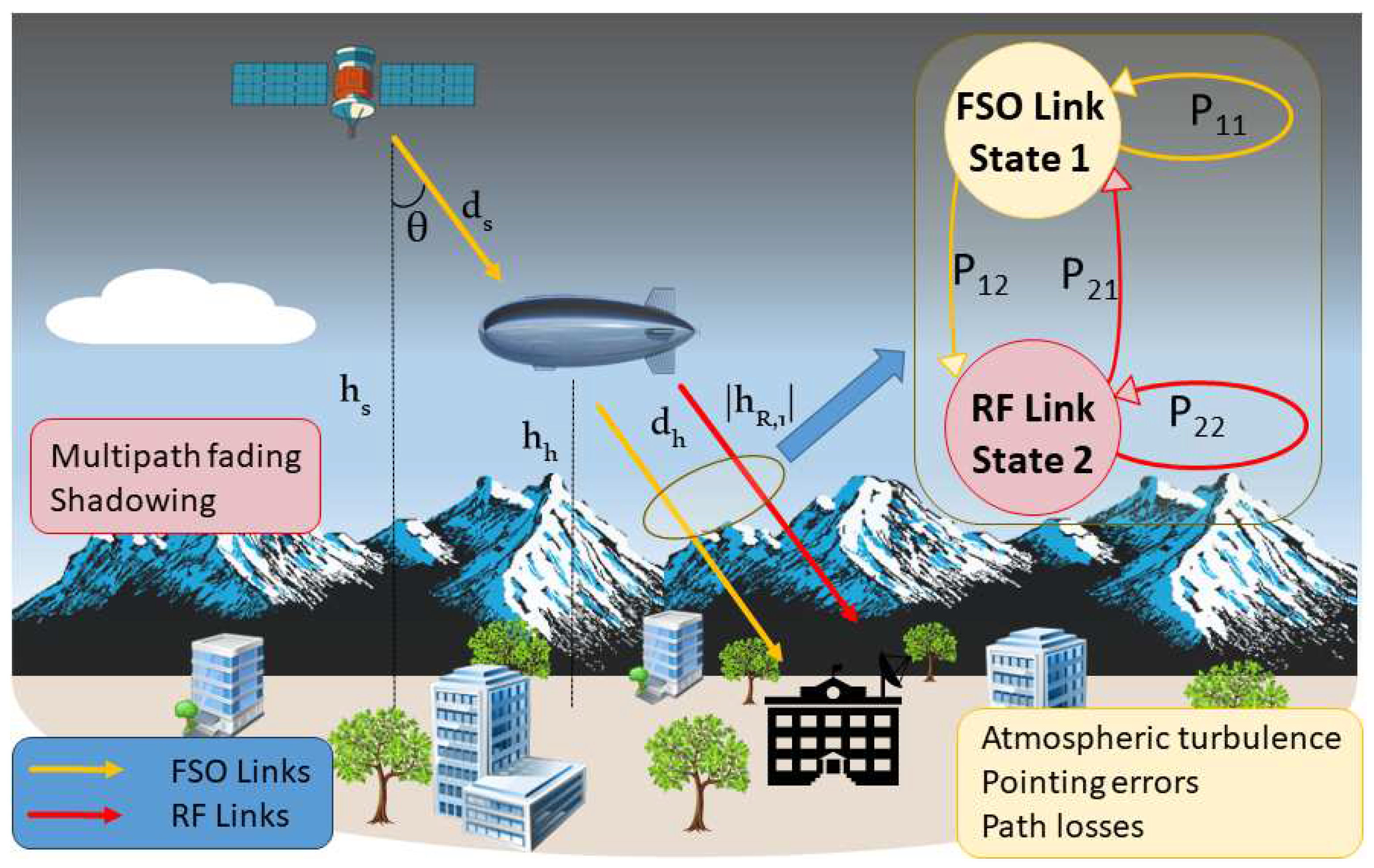
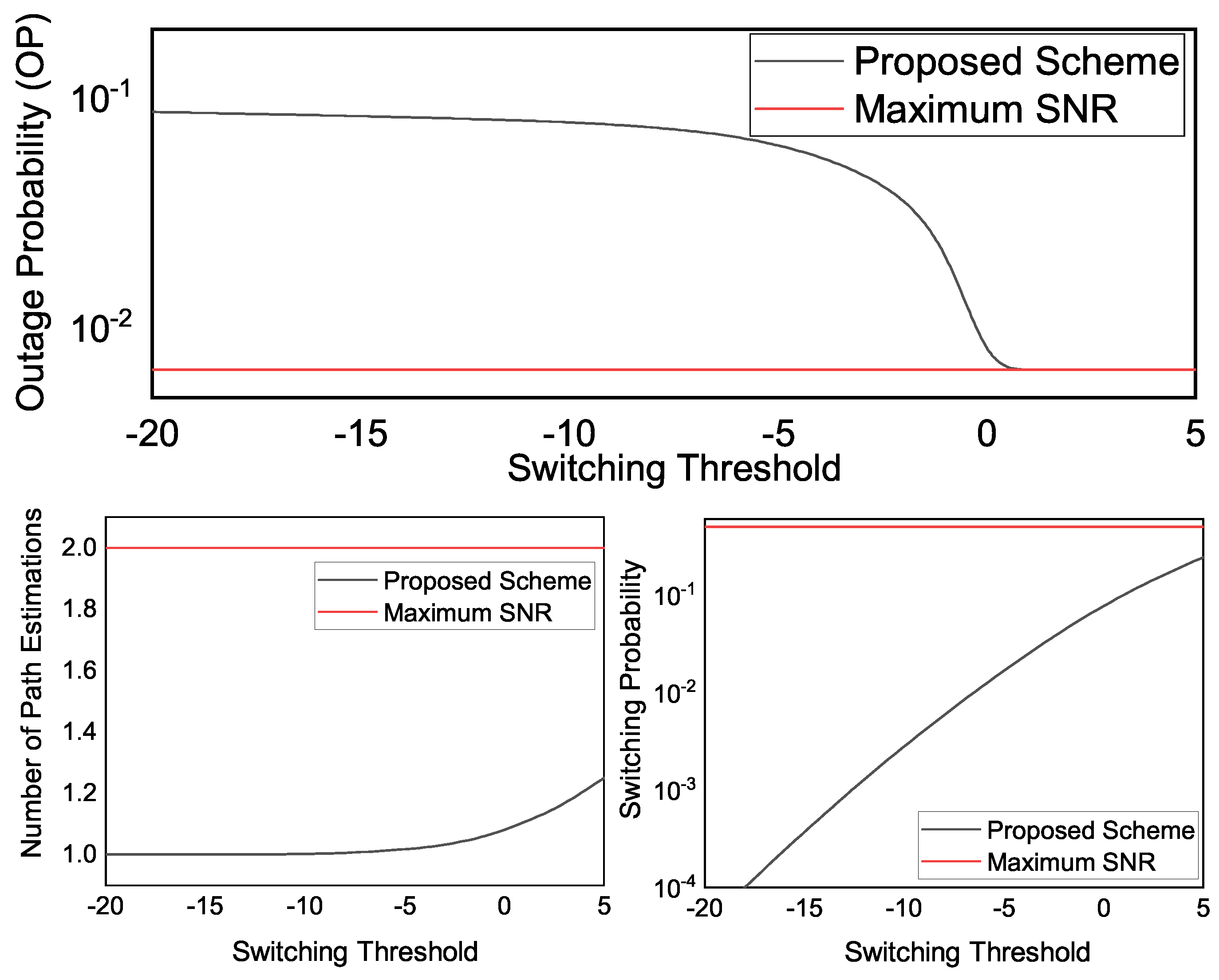
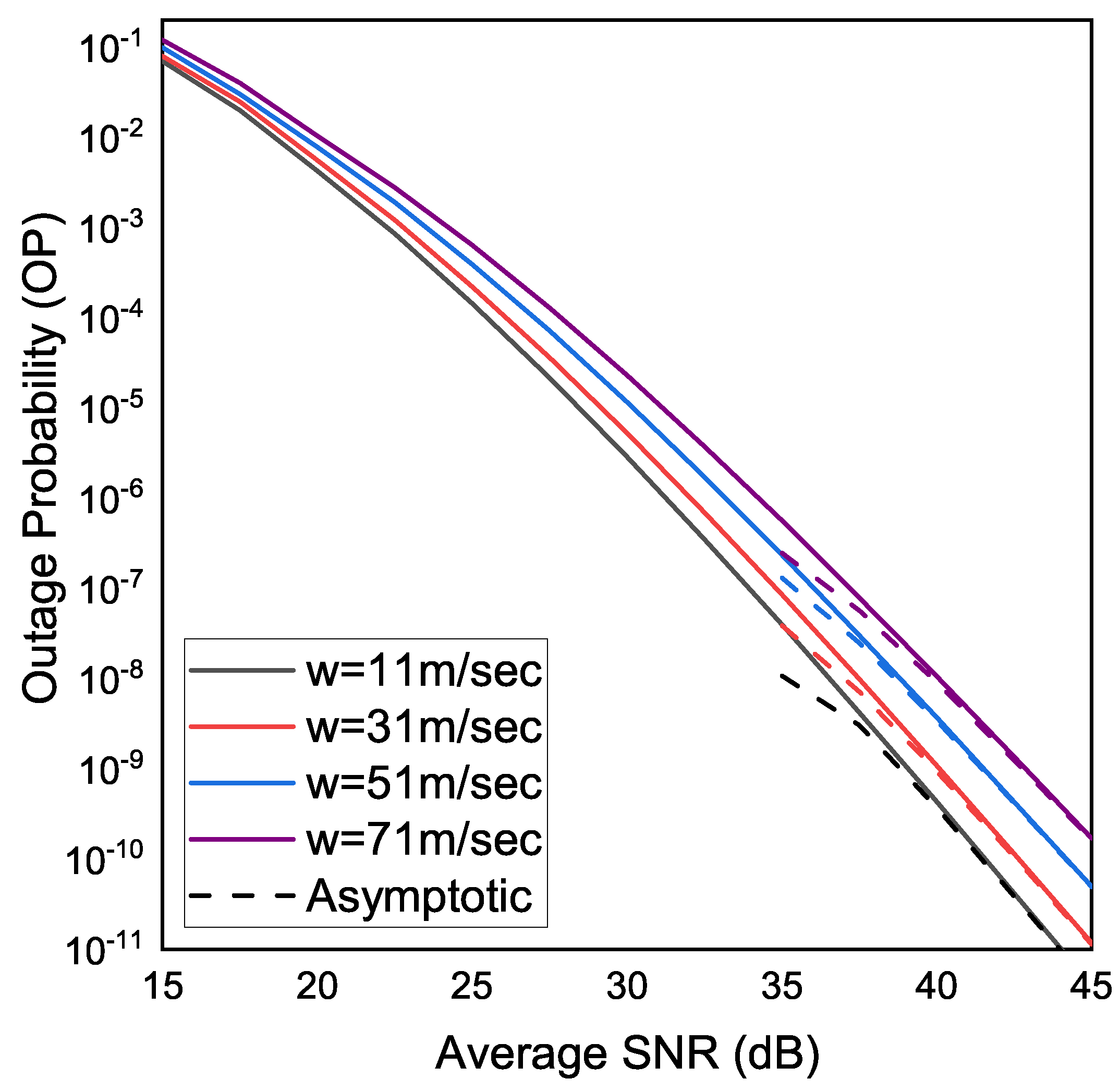
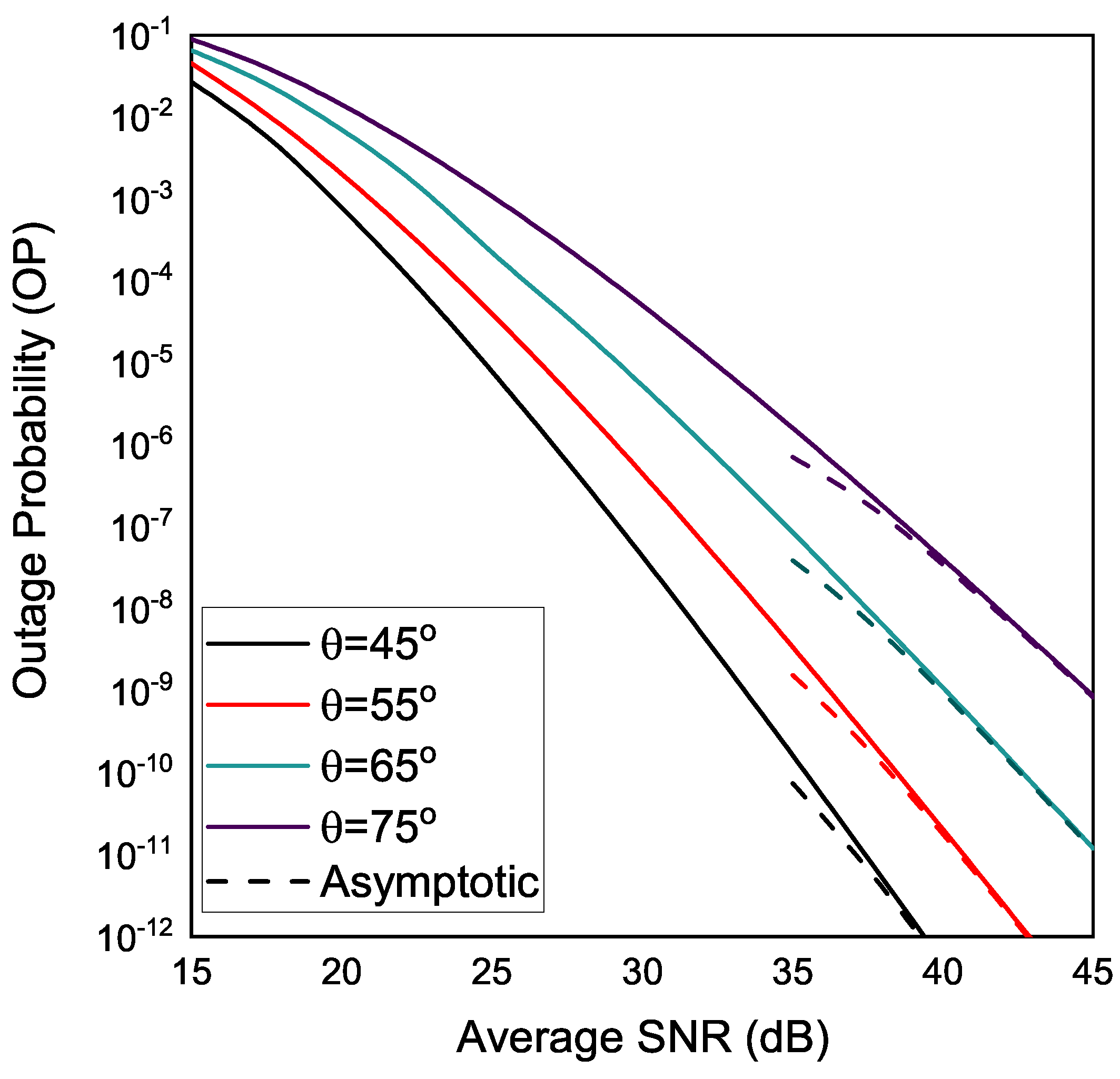
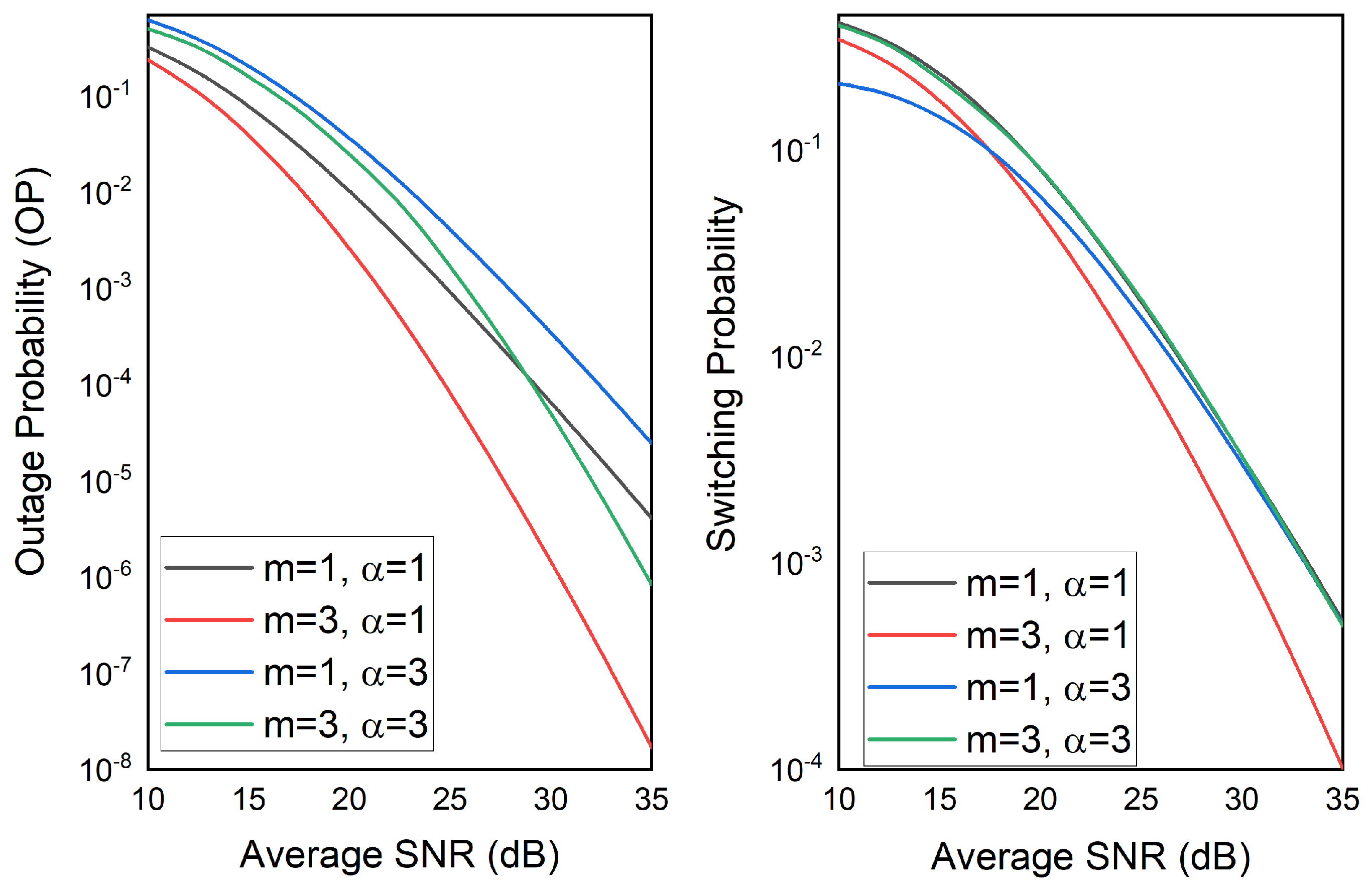
| Parameter | Definition | Value |
|---|---|---|
| FSO wavelength | 1550nm | |
| Satellite height | 620km | |
| HAPS height | 20km | |
| Ground station height | 10m | |
| Transmit telescope gain | 5dB | |
| FSO transmit power | 5dBm | |
| Receive telescope gain | 10dB | |
| Variance of the AWGN noise | ||
| Optical to electrical conversion coefficient | 0.8 | |
| Pointing error coefficient | 13.07 | |
| Zenith angle | ||
| w | Wind velocity | 41m/sec |
| Beam radius at the transmitter | 2cm | |
| Phase front radius of curvature of the beam | ∞ | |
| Small scale fading shaping parameters | ||
| Shadowing shaping parameters | ||
| v | Path loss factor | |
| Transmit power for RF communications | 20dBm | |
| Noise power | dBm | |
| RF transmit antenna gain | 20dB | |
| RF receive antenna gain | 20dBm | |
| RF links wavelength | m |
Disclaimer/Publisher’s Note: The statements, opinions and data contained in all publications are solely those of the individual author(s) and contributor(s) and not of MDPI and/or the editor(s). MDPI and/or the editor(s) disclaim responsibility for any injury to people or property resulting from any ideas, methods, instructions or products referred to in the content. |
© 2024 by the authors. Licensee MDPI, Basel, Switzerland. This article is an open access article distributed under the terms and conditions of the Creative Commons Attribution (CC BY) license (http://creativecommons.org/licenses/by/4.0/).





